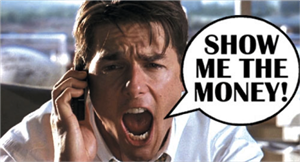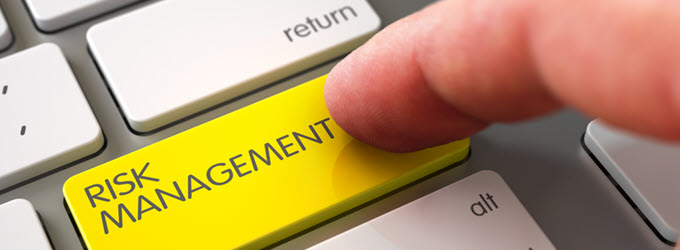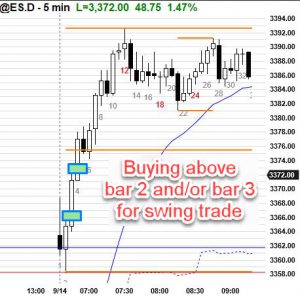How much per month can a swing trader make?
Trading room audio extract — Monday September 14, 2020
Updated September 26, 2020 – rerecorded audio and transcript.
Question: How much percent return per month do you think a swing trader can make?
General guideline
This is Al Brooks, and I’d like to talk a little bit today about how much a swing trader should expect to be making once he is successful.
I want to give you some general guidelines. There was a guy – his name was Peter Steidlmayer. I spent a week with him back in the 1980s. He was a professional trader, and he made a lot of money trading grains, corn, soybeans, back in the ’80s. He told me that he was trying to make about 2% a day as a professional trader, and he became very wealthy. He is also the guy who developed the Market Profile indicator, and it’s still used today. He made money from that as well. For him, making 1% or 2% a day was a reasonable goal, and I’m sure he did it for many years.
I think most traders should risk about 1% on any trade, maybe 2%. Therefore, if you have a $3,000 account and you’re risking 1% a day, you’re risking $30 for a beginner trader. You’re not going to get rich. I understand that. But if you have a $3,000 account, your goal is to first turn it into a $20,000 account and not to get rich right away. So for example, if you’re trading Micro Eminis with a $3,000 account and you’re trying to make $50 a day, you’re on a very good path.
Multiple trading accounts
Most traders should be thinking about trying to make a half percent a day, maybe 1% a day, risking 1% a day. Once you’ve been doing it for a long time and you have become profitable, you’ll tend to open multiple accounts, accounts with multiple brokers. Then with each broker, you’ll have different reasons to trade the different accounts. That’s what I have. I have a whole bunch of accounts, and when you add it all up, I have a pretty good trading account, or a pretty good collection of trading accounts. I never risk – I say I never risk; I don’t know for sure with my day trading, but it would be unusual for me to risk more than 1% of my trading capital on any one trade, and for that matter, on any one day.
Because of that, because I’m not risking all that much, I don’t worry about anything. But it took years to get to this point. That is not what a trader’s going to have when he starts out. He’s not going to have a lot of accounts with good size accounts. Most traders, when they start out, have one account, and they don’t have a lot of money. They cannot risk that much. This is especially true if you’re worried about money. You cannot be that flexible.
Four points a day
I think as a general rule, a really good day trader will be making about 1% a day, maybe 2% a day. Let’s say you have a $50,000 account and you’re making 4 points a day. That’s $200 in the Emini, and that’s just under a half percent a day. If you try to make consistently 4 points a day on average, that’s under just a half a percent a day. And if you’re a pretty good swing trader, you’ll probably make more, especially when the bars are as big as they have been lately. Right now, scalps are 5 points and swing trades are 10 to 20 points. A few months ago, a scalp was 1 or 2 points and a swing trade was maybe 4 points.
If you were to take one swing trade in the Micro Emini – for example, if you bought above Bar 2 today and you bought above Bar 3 today – you could hold it for 10 or 20 points, and there’s your $50 if you’re trading a Micro Emini. So if you had a $3,000 account and you traded a single Micro Emini, when the bars are big like they are today and if the legs are big like they are today, then you made more than your 1% today.
Actually, a fundamental question: what’s a reasonable percentage if you’re a swing trader? I think a reasonable minimum goal is a half percent. I think it would be hard to consistently make more than 2%, especially early in your trading career. But somewhere in that window, a half percent to 2%, half percent to 1%.
Let’s say there are about 200 trading days a year. There are not; it’s more like 220 trading days a year, but let’s say there are 200 trading days a year and you make 1% a day. Do you really make 200% a year if you make 1% a day? No. You’re really going to make a lot more than that because you’re risking the same percent every day, but as your account grows, you’ll be trading bigger. So it’s compounding. So instead of 1% a day for 200 days, resulting in a 200% gain, it’s more like a 400% gain per year if you’re really good and really aggressive.
Professional traders
What about professional traders? As a guideline, if you’re looking for a swing trade, if you’re making a half percent a day, you’re doing pretty well. Just look at any professional trader. If you look at the performance of hedge funds, some of them day trade a lot – for example, high frequency trading firms. Are they making 100%, 200%, 500% a year? No, they’re not. Most hedge funds manage money. If you show me a fund that consistently nets 10% a year with very little drawdown, maybe 3% or 4%, that fund will quickly be managing $10 billion, $100 billion, because everyone would want to make 10% a year if they’re risking only 3%. That’s a great result for the fund.
So most great professional traders – the billionaires of Wall Street, the hedge fund managers – they’re not making 1% a day. They’re not trying to make 1% a day. They’re trying to make 10% a year, maybe 20% a year. If they’re going for a bigger profit, 20% a year, they’re going to have bigger drawdowns. More reward, you’re going to need more risk.
If you’re looking to make 100% a year or 200% a year on your account, you’re looking to be better than the very best people on Wall Street. It’s doable, though, for really good individual traders. The people on Wall Street, those people managing other people’s money, they can’t take that kind of risk – the kind of risk that an individual trader can take. Also, they’re managing so much money. If you have a $10 billion fund, even if you wanted to risk 1%, you’d be trading thousands of Emini contracts, and it would be hard to get in and out if you’re trading thousands of contracts at a time, especially if you’re going for a small reward – 2, 3, or 4 points.
Individual trader benefits
As an individual trader, you’re never going to have to worry about the size of your position and getting filled properly. If you’re trading 1,000 contracts, your fills are not going to be what you would want if you were trying to make 100% a year or 200% a year. But as an individual trader, that’s never going to be a problem. You will never get big enough so that you have to worry about influencing the market and getting slippage. So that’s an advantage that an individual trader has.
No matter how big you trade, you’re never going to get too big, and that allows you to get in and out of the market many times a day without significant slippage, and you could end up making a lot of money. And if you’re good, you can get a very high percentage return on your account – better than most of the best firms on Wall Street.
But if you’re a day trader with a small account, I would be thinking in terms of trying to make about a half percent a day. So if you have a $5,000 account, try to average $50 a day. If you have a $50,000 account, you might try to average several hundred dollars a day. And if you’re trading a $50,000 account, you might be trading two Emini contracts, maybe three. I would not be trading 10 Emini contracts with a $50,000 account. If you trade one or two, that’s fine.
Think about the chart, not about the money

You want to make sure that you’re not thinking about money and losing money all the time. You have to be thinking about the chart and the trade and managing it properly, and you don’t want that to be influenced by worrying about losing too much money. One of the problems with trading too big a size for your account is that you’ll end up worrying too much about money, and you will make mistakes with the management. It will influence how you manage your account. You’re aware of a risk of ruin.
No matter how good a trader you are, there’s a risk of ruin. There’s a risk that your account will fall so low that you can no longer meet margin requirements and continue trading with that account. That’s called the risk of ruin. It’s also called blowing your account, and you don’t want to be worried about blowing your account. I’ve never blown an account. Even though I’ve traded a long time, I’ve never blown an account. Some professional traders have. They close the fund if their fund falls a certain amount – for example, if it loses half of its value.
So if you’re trading a $50,000 account and you’re trading two or three contracts, it becomes pretty difficult to risk only 1% or 2% of your account, so you’re probably trading too big. I would not be trading 10 Eminis with a $50,000 account. I would trade one or two. You have to avoid thinking about money, and if you risk too big, you’re going to be worrying about money. It’s very hard to risk only 1% or 2% on a $50,000 account if you’re trading two or three contracts because sometimes you have to risk 10 or even 20 points when the bars are very big, as they have been lately.
Stop placement on wide range days
Some of the days lately have had ranges of 80 points or 100 points. On some of those days, I risked over 50 points – 50, five-zero points, with my stop. I just sometimes dragged the stop on the price ladder far, far away. I don’t even pay attention to how far away it is. It’s very far away because if the bars are really big, I want to make sure that I’m using a stop based upon the price action. Sometimes that requires the stop to be very far away, and if the market starts to get close to the stop on the price ladder, then I’ll look closely at the chart and find out exactly where the stop has to be, and I’ll adjust it to make sure that it’s exact.
If you have a $50,000 account and you’re risking 50 points, as I have done lately – risked 50 points per contract on some trades – if you’re trading a $50,000 account, that is $2,500 per contract, and that’s 4% risk. That’s already too big if you have a $50,000 account. So if you’re trading a $50,000 account and you’re risking 50 points and one contract, that’s too big. You cannot do that. You have to trade smaller, like Micro Eminis. I think traders should be trying to risk no more than 1% or 2% of their account at any time, no matter how big their account is.
Risk per trade versus risk per day
Now, what about the issue of how much you’re risking per trade versus how much are you risking per day? Let’s say you’re willing to risk 2% of your account, and that’s absolute. So if your account is $50,000, 2% is $1,000. It doesn’t matter if you lose it on one trade today or on five trades today; that’s the end of your trading for the day.
Let’s say you have a $5,000 account and you’re risking 1%. That’s $50. If you’re risking $50 on one trade because the bars are reasonably big and you lose your $50, it’s probably better not to trade again today. You might try trading one more trade if there’s a good setup, especially if you can trade a smaller size, but if you lose again and you’ve lost 2% on the day, I would stop.
You can also talk about drawdown from the all-time high. If you started with a $5,000 account and it became a $10,000 account, then 2% drawdown now is $200, so you can risk more. But if it drops $200 from the $10,000 in any one day, whether it’s on one trade or several trades, I’d stop trading again for that day. Everybody has a different comfort level, but I think most traders would not want to lose more than 2% of their trading capital in any one day.
Drawdowns for beginner and experienced traders
I want to draw a distinction when I’m talking about drawdowns between a beginning trader and an experienced trader. A beginning trader is going to lose money for many months, possibly even a couple of years, and he has to be trading the absolute smallest position size possible, like a single micro Emini or 10,000 units in the Forex market. He has to make sure that his account is going to remain big enough to trade while he learns how to trade.
So the goal of a person starting out is different from a person who is already consistently profitable. A person starting out has to expect to lose money for a period of time. He should not be thinking in terms of drawdown; he should be thinking in terms of trading the smallest position size possible. So for example, as I said, trading a single Micro Emini contract or 10,000 units in the Forex market, and if he gets a couple losses in the day, stop trading that day and reevaluate. Look to try to understand what he did wrong and then try again tomorrow.
Do not lose more than 2% a day
A consistently profitable trader is still not going to want to lose more than 2% of his account in a day. If he’s down 5% in a week, he should probably reduce his risk per trade until he’s consistently winning again. So for example, if he was trading one Emini and his account fell 5% from the all-time high – let’s say the all-time high was 2 months ago – he should stop trading, at least for the rest of the day, and reevaluate what he’s doing and probably reduce his position size when he starts trading again next week. For example, if he was trading one Emini contract, he might start trading one Micro Emini contract next week for a day or two until he’s consistently profitable again, and then go back to his usual trading size, one Emini contract.
So that’s my overall thought about swing trading. I think a good swing trader, if he’s trading well, if he’s a consistently profitable trader, he should be thinking in terms of making about a half percent to 1% of his account size per day. And at some point, when you have multiple accounts and you have very big accounts, I don’t think in terms of that anymore. I just think about what is a comfortable amount of risk that I can take during the day, and then make whatever I can based on that risk. I would never be risking more than 1% or 2% of my entire trading accounts, my combined trading accounts, on any one trade or in any one day.
So I hope you found this useful. Again, this is Al Brooks. Thank you.



